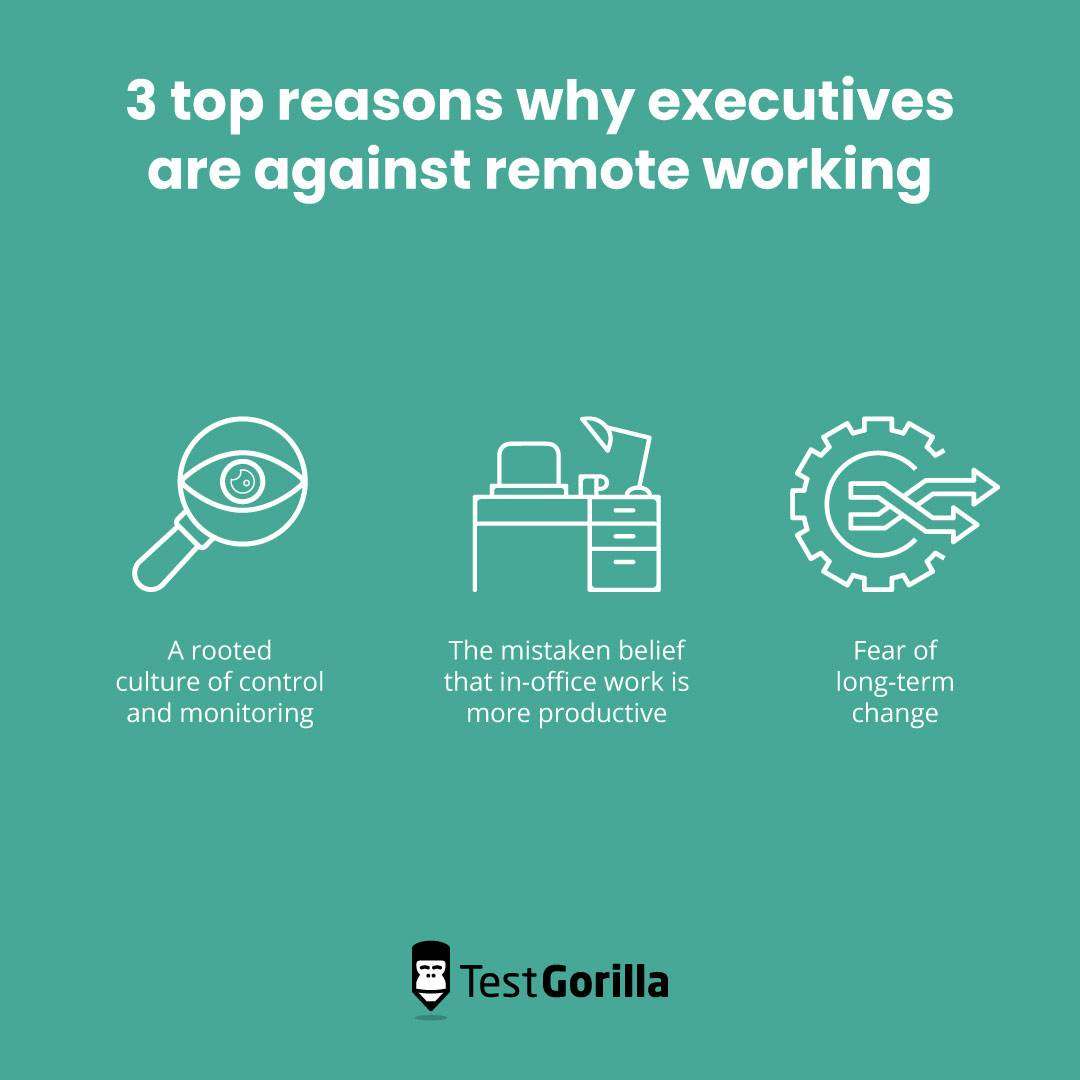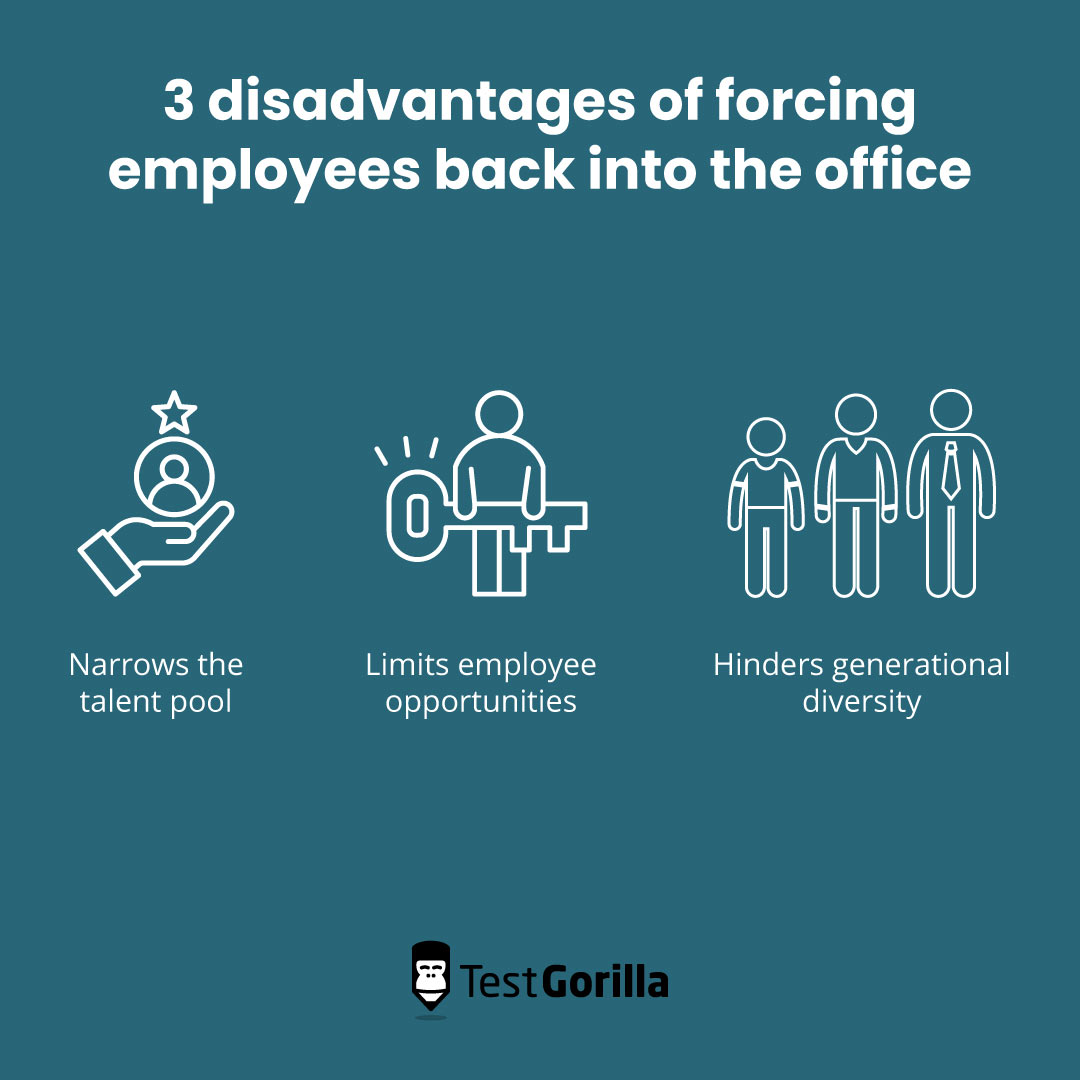Whether or not employees should return to the office is a polarizing debate – mainly between employees and executives.
Countless chief executives are demanding their staff come back to the office. But in a world with accessible remote tools like project management software and pre-employment testing, why the push?
Hybrid and remote work provide better opportunities for disabled candidates, working parents, and international workers. So who benefits from being in the office?
Executives may say in-person work is “tried and true,” but we believe there’s more to it.
This article discusses the reasoning behind the return-to-office pressure and why chief executive officers want to return to a pre-pandemic world, including a fear of change and a desire for control.
We also explore the benefits of skills-based hiring and how it empowers and encourages a healthy, remote workforce.
Table of contents
Why does the C-suite want to return to the office?
More executives than employees are pushing for a return to the office, but why? What’s this based on? Is it simply biased thinking, or do they have a point?
There’s definitely an underlying nuance to this argument – a deeper reason.
For example, Steven Spielberg once announced his stance on streaming films. Namely, that it wasn’t the same as being in a theater.
Netflix made a counterargument that streaming films is much more accessible for everyone. It enables everyone to enjoy movies and gives filmmakers more ways to share their art. This caused Spielberg to change his mind and retract his statement.
Ironically, Reed Hastings, a cofounder of Netflix, is infamously against remote work. Even during the thick of the pandemic, he requested his employees come back to the office “12 hours after a vaccine is approved.”
There must be an underlying reason for this push when the cofounder of a remote streaming platform thinks that being in-person is essential.
We’re going to discuss a few of the top reasons people believe executives are pushing for a return to the office:
A rooted culture of control and monitoring
The mistaken belief that in-office work is more productive
Fear of long-term change
A rooted culture of control and monitoring
Countless business leaders have a long-standing culture of control and monitoring.
Many executives believe the only way to ensure hard work and productivity is through micromanaging and physical conversations.
Michael Bush, the chief executive officer of Great Place to Work, believes this push for returning to the office stems from “control issues.”
Bush says the people who work for these leaders are actively “updating their profiles on LinkedIn” and searching for new roles.
Remote work gives employees a high level of autonomy, and executives are worried this could make them slack off or break rules.
Research has shown that the opposite is true. A study by Harvard Business Review found that monitoring employees actually makes them more likely to break the rules or slack off. This behavior can be mitigated by treating employees fairly and giving them agency.
Then what do executives have to worry about?
This stance on control comes from a fundamental misunderstanding of the employee–management relationship.
Believing that control produces better work is a holdover from a more task-based system of work, and it doesn’t carry over to today’s more agile working practices. We’ll talk about this in depth down below.
Not all of this mistrust is intentional – a lot of it is unconscious. Many executives have spent the majority of their careers physically monitoring people, so it’s starkly different not being able to watch them.
For more insights on this topic, read our blog on trust in the workplace.
The mistaken belief that in-office work is more productive
Many executives believe that in-office work is more productive, builds better relationships, and leads to better outcomes.
One of the most recent leaders to announce this stance is Mark Zuckerberg, the chief executive officer of Facebook.
Zuckerberg announced that his data shows engineers who had some in-person working time (even if they later transitioned to remote work) performed better than those who joined the company remotely.
However, countless studies have proven this to be incorrect.
The State of Remote Work by OwlLabs found 90% of employees say their work is the same level of productivity or higher.[1]
A 2015 study found similar results: 77% of remote workers say they’re more productive when working from home, with 30% doing more in less time and 24% doing more work in the same amount of time.
This research means that remote productivity was higher years ago, even before the boom in technology that facilitated group communication, project management, and video conferencing.[2]
Fear of long-term change
This reason is prevalent for many executives, even if they don’t realize it.
Some chief executives were never happy with remote work but consented to it, believing that it would only be temporary. To these executives, a distributed workforce was okay as long as it was strictly necessary.
However, the thought of long-term change is overwhelming to many people. It changes the entire idea of the workplace, taking people out of their comfort zones.
Chancellor Jeremy Hunt, a British politician, is an example of this. He believes in-office work should be “default,” although he offers the opinion that remote work is useful for those who need it, such as disabled employees and working parents.[3]
This shows that some people see the merit in remote work, but they “default” back to in-office work because of old, deeply rooted traditions.
This is especially likely for older generations, such as Baby Boomers. It can be difficult to handle change when in-office work has been the norm for your entire 30- to 40-year career.
Is a forced return beneficial for companies and workers?
Increasing numbers of executives are announcing a return to the office, and this has a detrimental impact on organizations.
Forcing employees back into the office has many disadvantages, including narrowing your talent pool, limiting employee opportunities, and hindering generational diversity.
All of these points also damage your brand image.
Let’s take a closer look.
Narrows the talent pool
When an organization has strict in-office rules, all employees need to be from a specific geographical area.
To work comfortably, people must be at most within one hour’s commute of your company building. This not only excludes top talent from other regions, countries, and states, but it also excludes candidates from a mere two to three hours away.
Narrowing your talent pool is never a good thing for a business, but it’s particularly detrimental during a global skills shortage.
The Great Reshuffle has made a wide talent pool more important than ever. Talent is in high demand, and narrowing it for in-office work isn’t worth it.
Prioritizing remote work has amazing benefits for your talent pool. For example, TestGorilla is a 100% remote company that has teammates from all over the globe.
Wouter Durville, our chief executive officer, believes the future of the workplace includes remote work – specifically to help unlock global talent pools.
We couldn’t agree more. We’re more than grateful for our diverse, hard-working team, and it’s all possible through a distributed workforce.
Limits employee opportunities
There are many employees who simply cannot join a company that’s strictly in-office.
Calling for a tight return to office limits opportunities for thousands of candidates, namely disabled people, neurodivergent people, working parents, and international candidates.
For some of these people, it’s difficult or impossible to come into the office. For others, it’s a matter of anxiety and social pressure.
An example of a remote-based working parent and executive is Jochen Zeitz, the chief executive officer of Harley-Davidson.
A combination of the pandemic and fatherhood pushed him to promote a remote workforce. He believes that physical office spaces are “less inclusive” and that remote work enables flexibility for everyone involved.
Zeitz had this to say about remote work:
“It democratizes the way we work together and allows you to bring the best talent into the company, no matter where they sit.”
Zeitz has also announced that he plans to repurpose their old headquarters at some point to show how serious he is about a distributed workforce.[4]
Hinders generational diversity
Thousands of employees are looking for distributed work, especially younger generations.
A large number of Gen Z and Millennial employees are demanding remote work. One study found that 77% of Gen Z workers and 71% of Millennial workers in the UK would consider looking for a new job if their employers asked them to come to the office full-time.[5]
A common argument from executives in favor of in-office work is that remote work isn’t productive or social enough. Studies have proven this idea wrong, but beyond that, the idea of productivity and socializing is subjective and generational.
We believe Channel NewsAsia puts it well:
“Productivity and social relations at work mean different things across generations.”[6]
To enable remote and hybrid work is to facilitate multiple working generations. Many executives tend to be from the Baby Boomer generation, and their ideas on work-life balance, productivity, and socialization are different from younger generations.
One idea isn’t strictly wrong or right, but it may mean younger generations find it more efficient to work from home.
For more on how different generations perceive work, read our blog on generational diversity.
How skills-based hiring helps us shape a better future for work
So what’s skills-based hiring’s role in all of this?Skills-based practices are a part of the future of work, just like distributed work. They also go hand in hand with remote work practices.Skills-based hiring helps us move past deeply entrenched convictions about how the workplace is “meant to be” and build a better environment for all.Here’s a quick summary of how skills-based hiring enables remote work, and vice versa:
Hire employees with the skills to succeed
Recruit motivated and determined candidates
Build a more positive, trusting culture across all levels of the organization
Nurture a strong, dynamic team
Open your talent pool and access diverse candidates
1. Hire employees with the skills to succeed
Chief executive officers can relax their control over employees when they know they have the skills to succeed.Skills-based hiring practices, like skills assessments and structured interviews, enable hiring managers to gauge real skills and capabilities.Resumes only allow for guesswork, and countless candidates have admitted to lying on them. It’s also worth noting that even people who aren’t lying may have a different idea about their skills than you do.Skills-based practices, however, evaluate a candidate accurately and objectively. TestGorilla’s State of Skills-Based Hiring report found 92.5% of organizations that used skills-based hiring saw a reduction in mis-hires.When you’ve accurately assessed your employees’ abilities, it’s much easier to take a breath and relax – because you trust your employees are well-equipped to be productive.
2. Recruit motivated and determined candidates
Skills tests can gauge other important factors beyond technical skills: motivation and culture.Knowing that your candidates are motivated and determined to work hard without having to be monitored puts your mind at ease. Hiring with skills tests boosts an employee’s motivation and confidence because they ensure the candidate has the right skills to perform well in their role.You can also assess your workers with a Motivation test. This helps you establish a candidate’s key motivators and determine if they align with your company.This is also related to culture.Hiring employees that align with your organization’s culture makes a more suitable employee-organization match. A culture match helps employees stay focused to accomplish company goals, driving their effort and decisions.We recommend using our Culture add test to determine a candidate’s values and beliefs. Culture add is distinct from culture fit because it prioritizes diversity and downplays the idea that employees have to be a certain “fit” to succeed at a company.For more information, read our blog on culture add vs. culture fit.
3. Build a more positive, trusting culture across all levels of the organization
A focus on skills helps build a healthier, more trusting culture. Skills-based hiring promotes employee wellbeing in many ways. It takes emphasis off connections, work history, education, and experience, and puts the focus where it should be: whether or not they can do the job.These practices encourage inclusivity and diversity, and they allow for a greater level of psychological safety.For example, skills-based hiring is one of our top ways to support neurodivergent adults at work. Focusing on capabilities helps reduce social anxiety in neurodivergent employees, enabling them to complete their work comfortably.Skills-based practices also help employees stay satisfied and motivated. Our report found that 72.1% of people hired via skills-based hiring are happy in their role, versus 62.9% of people hired through traditional means.A greater level of satisfaction and trust improves remote working conditions, encouraging healthy communication and reducing micromanaging.
4. Nurture a strong, dynamic team
Skills-based hiring facilitates an agile workforce, and it’s by far the best recruitment technique for building a flexible, dynamic team that can work from anywhere.Skills-based practices combined with remote work enable role flexibility, which helps companies stay agile in uncertain times.When a company views its people as a collection of skills rather than a rigid “role” with set responsibilities, it can better react to sudden change and supply talent wherever needed.This is called talent sharing, and it’s the act of borrowing talent from other departments to fulfill current needs. Role flexibility and talent sharing are easier when work is hybrid or remote. For example, borrowing in-office talent from another department is impossible if the teams are based in different states.The future has to be flexible to keep up with constantly shifting skills, and skills-first remote work not only makes this possible, but also efficient and adaptable.For more information on the topic of agility, read our article on how skills-based organizations become more adaptable.
5. Open your talent pool and access diverse candidates
A combination of skills-based hiring and remote work enables you to reduce bias and reach more candidates than ever.Focusing on skills rather than work history or geographical location opens your talent pool so you can access fresh talent, perspectives, and innovative thinking. And we aren’t just guessing – TestGorilla’s State of Skills-Based Hiring report found that 91.1% of organizations saw an increase in diversity after implementing skills-based hiring.Additionally, eliminating the need for a strict geographical location means you can hire more disabled people, people with social anxiety, and people without easy access to transportation.A real-life example is our team at TestGorilla. A combination of skills-based hiring and remote work allows us to not only have thought diversity but geographical diversity.Our distributed workforce is positioned all over the globe:
North America
Africa
Asia
Australia
South America
Europe
We also have identity and gender diversity, including team members who identify as LGBTQ+ and an equal gender balance among leadership and department heads.
Use skills assessments to hire a diverse, distributed workforce
Many executives are calling for a return to office, but we stand firm in favor of distributed work. A remote workforce is beneficial to everyone involved. We believe that when faced with the facts, most executives will choose the option that nurtures their organization’s continued growth and success. For the best results, we recommend combining remote work with skills-based hiring. These practices together help reduce hiring bias, nurture a healthy culture, and increase organizational agility.For tips on how to adopt remote and hybrid work, read our guide on creating a flexible working policy.To prepare a candidate or employee for distributed work and assess their ability to be managed remotely, try our Understanding Instructions test. Sign up for a free plan and see how you can use TestGorilla’s skills assessment platform to hire a diverse, distributed workforce.
Sources
“State of Remote Work 2021”. (2021). OwlLabs. Retrieved June 26, 2023. https://owllabs.com/state-of-remote-work/2021
Wright, Aliah D. (February 13, 2015). “Study: Teleworkers More Productive—Even When Sick”. SHRM. Retrieved June 26, 2023. https://www.shrm.org/resourcesandtools/hr-topics/technology/pages/teleworkers-more-productive-even-when-sick.aspx
Race, Michael. (May 17, 2023). “Chancellor Jeremy Hunt: Office working should be default”. BBC. Retrieved June 26, 2023. https://www.bbc.com/news/business-65621081
Coppola, Gabrielle; Welch, David. (October 17, 2022). “Harley rethinks its headquarters as CEO rejects a return to office”. Bloomberg. Retrieved June 30, 2023. https://www.irishtimes.com/business/2022/10/18/harley-rethinks-its-headquarters-as-ceo-rejects-a-return-to-office/
“Two thirds of UK Gen Zs and millennials opt for remote and hybrid working”. (May 17, 2023). Deloitte. Retrieved June 26, 2023. https://www2.deloitte.com/uk/en/pages/press-releases/articles/two-thirds-of-uk-gen-zs-and-millennials-opt-for-remote-and-hybrid-working.html
Tett, Gillian. (July 18, 2022). “Commentary: Why CEOs are so concerned about their staff working from home”. Channel News Asia. Retrieved June 26, 2023. https://www.channelnewsasia.com/commentary/ceo-dislike-wfh-companies-return-office-2816506
Related posts
Hire the best candidates with TestGorilla
Create pre-employment assessments in minutes to screen candidates, save time, and hire the best talent.
Latest posts
The best advice in pre-employment testing, in your inbox.
No spam. Unsubscribe at any time.

Hire the best. No bias. No stress.
Our screening tests identify the best candidates and make your hiring decisions faster, easier, and bias-free.
Free resources
This checklist covers key features you should look for when choosing a skills testing platform
This resource will help you develop an onboarding checklist for new hires.
How to assess your candidates' attention to detail.
Learn how to get human resources certified through HRCI or SHRM.
Learn how you can improve the level of talent at your company.
Learn how CapitalT reduced hiring bias with online skills assessments.
Learn how to make the resume process more efficient and more effective.
Improve your hiring strategy with these 7 critical recruitment metrics.
Learn how Sukhi decreased time spent reviewing resumes by 83%!
Hire more efficiently with these hacks that 99% of recruiters aren't using.
Make a business case for diversity and inclusion initiatives with this data.






















